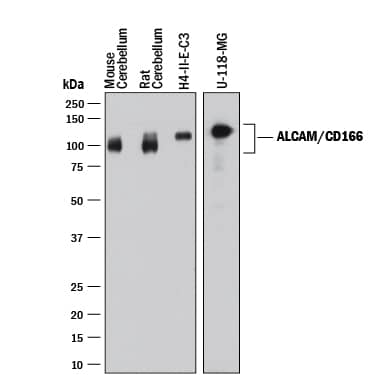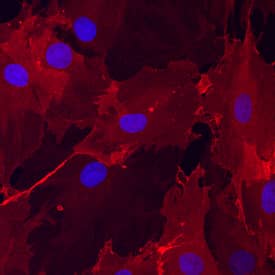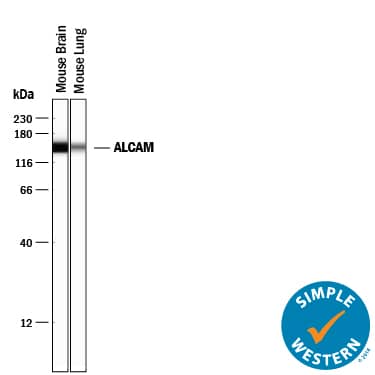Human/Mouse/Rat/Canine ALCAM/CD166 Antibody
R&D Systems, part of Bio-Techne | Catalog # AF1172

Key Product Details
Validated by
Species Reactivity
Validated:
Cited:
Applications
Validated:
Cited:
Label
Antibody Source
Product Specifications
Immunogen
Trp28-Lys527
Accession # AAC06342
Specificity
Clonality
Host
Isotype
Scientific Data Images for Human/Mouse/Rat/Canine ALCAM/CD166 Antibody
Detection of Human, Mouse, and Rat ALCAM/CD166 by Western Blot.
Western blot shows lysates of mouse brain (cerebellumn) tissue, rat brain (cerebellum) tissue, H4-II-E-C3 rat hepatoma cell line, and U-118-MG human glioblastoma/astrocytoma cell line. PVDF membrane was probed with 0.2 µg/mL of Goat Anti-Mouse/Rat/Canine ALCAM/CD166 Antigen Affinity-purified Polyclonal Antibody (Catalog # AF1172) followed by HRP-conjugated Anti-Goat IgG Secondary Antibody (Catalog # HAF017). A specific band was detected for ALCAM/CD166 at approximately 90-120 kDa (as indicated). This experiment was conducted under reducing conditions and using Immunoblot Buffer Group 1.Detection of ALCAM/CD166 in Mouse Splenocytes by Flow Cytometry.
Mouse splenocytes either (A) activated or (B) resting were stained with Goat Anti-Mouse/Rat/Canine ALCAM/CD166 Antigen Affinity-purified Polyclonal Antibody (Catalog # AF1172) followed by Phycoerythrin-conjugated Anti-Goat IgG Secondary Antibody (Catalog # F0107) and Rat Anti-Mouse B220/CD45R APC-conjugated Monoclonal Antibody (Catalog # FAB1217A). Quadrant markers were set based on control antibody staining (Catalog # AB-108-C).Detection of ALCAM/CD166 in Canine PBMCs by Flow Cytometry.
Canine peripheral blood mononuclear cells (PBMCs) treated with PMA and Calcium Ionomycin for 24 hours were stained with Goat Anti-Mouse/Rat/Canine ALCAM/CD166 Antigen Affinity-purified Polyclonal Antibody (Catalog # AF1172, filled histogram) or isotype control antibody (Catalog # AB-108-C, open histogram), followed by Phycoerythrin-conjugated Anti-Goat IgG Secondary Antibody (Catalog # F0107).Applications for Human/Mouse/Rat/Canine ALCAM/CD166 Antibody
CyTOF-ready
Flow Cytometry
Sample: Mouse splenocytes and canine peripheral blood mononuclear cells (PBMCs) treated with PMA and Calcium Ionomycin
Immunocytochemistry
Sample: Immersion fixed undifferentiated rat mesenchymal stem cells
Immunohistochemistry
Sample: Perfusion fixed frozen sections of mouse liver and thymus
Simple Western
Sample: Mouse brain (total) tissue and mouse lung tissue
Western Blot
Sample: Mouse brain (cerebellumn) tissue, rat brain (cerebellum) tissue, H4‑II‑E‑C3 rat hepatoma cell line, and U‑118‑MG human glioblastoma/astrocytoma cell line
Reviewed Applications
Read 2 reviews rated 4.5 using AF1172 in the following applications:
Formulation, Preparation, and Storage
Purification
Reconstitution
Formulation
Shipping
Stability & Storage
- 12 months from date of receipt, -20 to -70 °C as supplied.
- 1 month, 2 to 8 °C under sterile conditions after reconstitution.
- 6 months, -20 to -70 °C under sterile conditions after reconstitution.
Background: ALCAM/CD166
ALCAM, activated leukocyte cell adhesion molecule, is a type I membrane glycoprotein and a member of the immunoglobulin supergene family. It is also known as CD166, MEMD, SC-1/DM-GRASP/BEN in the chicken, and KG-CAM in the rat. ALCAM is expressed on thymic epithelial cells, activated B and T cells, and monocytes. ALCAM can bind itself homotypically and is also capable of binding CD6, NgCAM, and other, as of yet, unidentified brain proteins. ALCAM/CD6 interaction may be involved in T cell development and T cell regulation. Additionally, ALCAM/CD6 and ALCAM/NgCAM interactions may play roles in the nervous system. ALCAM has also been observed to be upregulated on highly metastasizing melanoma cell lines and may play a role in tumor migration. ALCAM is a 583 amino acid (aa) protein consisting of a 27 aa signal peptide, a 500 aa extracellular domain, a 24 aa transmembrane domain, and a 32 aa cytoplasmic domain. The extracellular domain of ALCAM contains 5 Ig-like domains of which the amino-terminal V1 domain is essential for ligand binding and ALCAM-mediated cell aggregation (1-4). The ECD of mouse ALCAM shares 97.5% and 93.2% aa sequence identity with rat and canine ALCAM ECD, respectively.
References
- Bowen, M.A. et al. (1995) J. Exp. Med. 181:2213.
- Aruffo, A. et al. (1997) Immunol. Today 18:498.
- Degen, W.G. et al. (1998) Am. J. Pathol. 152:805.
- Van Kempen, L. et al. (2001) J. Biol. Chem. 276:25783.
Long Name
Alternate Names
Gene Symbol
UniProt
Additional ALCAM/CD166 Products
Product Documents for Human/Mouse/Rat/Canine ALCAM/CD166 Antibody
Product Specific Notices for Human/Mouse/Rat/Canine ALCAM/CD166 Antibody
For research use only





